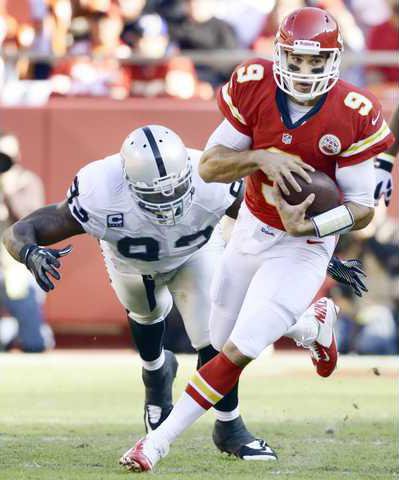KANSAS CITY, Mo. — Brady Quinn had waited three years for another chance to be a starting quarterback in the NFL. He wasn’t going to let a concussion put him back on the sideline.
That’s why the Chiefs quarterback admitted Wednesday to attempting to play through his second concussion of the season, which he believes happened when a defender’s knee struck the back of his helmet in a game against the Oakland Raiders on Oct. 28.
Quinn remembers having vision problems after the blow, but decided to remain in the game, even though he was dazed enough to put on the wrong helmet on the sideline between possessions.
He never saw the Raiders’ Rolando McClain while getting sacked later in the first quarter, perhaps augmenting the severity of the initial concussion, and recalled having “tunnel vision” and being unable to see the Oakland defensive backs when he threw an interception.
It was at that point Quinn was removed from the game.
“That’s why I tried to stay in the game, because it was the first opportunity for me in a while,” said Quinn, speaking for the first time since the injury. “I tried to play through it, and that’s my fault for not being smart about it.”
Quinn has already been ruled out for Kansas City’s game Monday night at Pittsburgh. It will be the second straight game he’s missed since becoming the starting quarterback.
The former first-round draft pick sustained his first concussion this year when he got hit while scrambling during a preseason game at Green Bay. Quinn said he blacked out for a few seconds after the blow, and then saw stars, but everything started to clear up after a few minutes.
The latest concussion seems to be lingering, Quinn said, giving him reason for concern.
“It’s definitely a thought,” he said, “because it is the second one this year, and if you come back too soon, before your symptoms calm down, it does involve some risk.”
The very fact that Quinn refused to remove himself from the game typifies a “gladiator-like” culture that NFL executives are trying to change, and the lengths that some players are willing to go to maintain their tenuous grasp on a job.
The issue of player safety has been thrust into the spotlight amid widespread reports of dementia in former players, and with approximately 3,500 ex-players involved in various lawsuits claiming the NFL has mishandled or ignored head injuries. The scrutiny has resulted in thousands of dollars in fines handed out by the league for unsportsmanlike conduct or unnecessary roughness.
The players’ union has requested that the NFL place independent neurologists on the sidelines of every game and include them as part of the initial concussions examination protocol. For now, when a player shows signs of head trauma, immediate examinations are conducted by team physicians.
Quinn said he’s currently being evaluated by Dr. Micky Collins, the executive director of the UPMC Sports Medicine Concussion Program in Pittsburgh, one of the leading experts in the diagnosis, treatment and rehabilitation of athletes who have suffered concussions.
Collins helped design the ImPACT test now used by many professional sports leagues, including the NFL, to assess concussions and determine when an injured athlete can safely return to play.
Among the athletes he’s treated for concussions are the Penguins’ Sidney Crosby and NASCAR driver Dale Earnhardt Jr., who sustained two of them in a six-week span earlier this season.
“They’re the best. When you go to try to find help in an area like this, with their expertise, they’re the most advanced,” Quinn said. “They’ve put together a great plan to kind of rehab it and get it back to where it was before the hits.”
Quinn said that Collins put him through “a litany of tests,” everything from vision acuity to the strength of his eye muscles, and even how quickly he recovered after a workout.
He’s been cleared for light exercise but not for contact.
“The doctors themselves don’t really know when they’ll be clear of concussion symptoms,” Chiefs coach Romeo Crennel said Wednesday. “They test him and when he’s clear, and he shows no residual effects, they can say, ‘Ok, you’re cleared.’”
In the meantime, Matt Cassel will resume his job as the Chiefs’ quarterback.
Cassel has been the starter the past three seasons, but lost the job after sustaining his own concussion in a game against Baltimore earlier this year. Cassel wasn’t cleared for his next start, and Crennel gave the job to Quinn on a permanent basis following the Chiefs’ bye week.
“I feel like I’m the starter until told otherwise,” Cassel said. “I’m excited about having another opportunity, and when Brady comes back and he’s healthy, we’ll see what happens.”
Nobody is certain when that will happen, though.
“I don’t know. I’m not a doctor,” Quinn said. “This is my second one this year, and I think there’s obviously a concern for those sorts of things. If you go back too soon, you have a risk of getting a third one real quick, and who knows after that.”
As for the long-term ramifications of the concussions, which have resulted in dementia and other problems among former players, Quinn said it remains in the back of his mind.
“It’s something we’re starting to learn more and more about,” he said. “They kind of do start to stack up when they’re not treated in the proper way.”
Quinn admits trying to play through concussion
NFL





